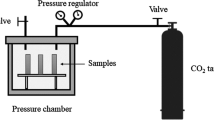Abstract
Electrical resistivity and sorptivity are properties related to concrete durability. Electrochemical corrosion is a degradation process that can be monitored with electrical resistivity analysis. Concrete carbonation is directly related to corrosion, reducing the microstructures pH and causing despassivation of the steel. Thus, this paper evaluated the influence of carbonation on electrical resistivity and sorptivity of concrete specimens mixed with three water-cement ratio (0.4, 0.5 and 0.6). Carbonation was accelerated through a chamber, with temperature, relative humidity and CO2 concentration controlled. The carbonation depth for water-cement ratios of 0.4, 0.5 and 0.6 was 7.6, 10.5 and 13.4 mm, respectively (45 days of exposure). The results suggest that carbonation increases both electrical resistivity and sorptivity for concretes with same water-cement ratios. It is related to the pore refinement and decrease in pore diameter caused by carbonation reaction. From correlations between tests, high values for determination coefficient were found, between 0.946 and 0.990.









Similar content being viewed by others
References
Balestra CET, Lima MG, Silva AR, Medeiros-Junior RA (2016) Corrosion degree effect on nominal and effective strengths of naturally corroded reinforcement. J Mater Civil Eng 28:1–9. https://doi.org/10.1061/(ASCE)MT.1943-5533.0001599
Souza DJ, Yamashita LY, Dranka F, Medeiros MHF, Medeiros-Junior RA (2017) Repair mortars incorporating multiwalled carbon nanotubes: shrinkage and sodium sulfate attack. J Mater Civil Eng 29:04017246. https://doi.org/10.1061/(ASCE)MT.1943-5533.0002105
Mazer W, Lima MG, Medeiros-Junior RA (2017) Fuzzy logic for estimating chloride diffusion in concrete. Proc Inst Civil Eng Struct Build 171:542–551. https://doi.org/10.1680/jstbu.16.00153
Zhou Y, Gencturk B, Willam K, Attar A (2014) Carbonation-induced and chloride-induced corrosion in reinforced concrete structures. J Mater Civil Eng 27:04014245. https://doi.org/10.1061/(ASCE)MT.1943-5533.0001209
Medeiros-Junior RA, Lima MG, Yazigi R, Medeiros MHF (2015) Carbonation depth in 57 years old concrete structures. Steel Compos Struct 19:953–966. https://doi.org/10.12989/scs.2015.19.4.953
Medeiros MHF, Raisdorfer JW, Hoppe Filho J, Medeiros-Junior RA (2017) Partial replacement and addition of fly ash in Portland cement: influences on carbonation and alkaline reserve. J Build Pathol Rehabil 2:1–9. https://doi.org/10.1007/s41024-017-0023-z
Kirchheim AP, Rheinheimer V, Dal Molin DCC (2015) Comparative study of white and ordinary concretes with respect of carbonation and water absorption. Constr Build Mater 84:320–330. https://doi.org/10.1016/j.conbuildmat.2015.03.020
Ashraf W (2016) Carbonation of cement-based materials: challenges and opportunities. Constr Build Mater 120:558–570. https://doi.org/10.1016/j.conbuildmat.2016.05.080
Medeiros-Junior RA, Lima MG, Medeiros MHF (2014) Investigação da resistência à compressão e da resistividade elétrica de concretos com diferentes tipos de cimento. Revista Alconpat 4:113–128. https://doi.org/10.21041/ra.v4i2.21
Yousuf F, Wei X, Tao J (2017) Evaluation of the influence of a superplasticizer on the hydration of varying composition cements by the electrical resistivity measurement method. Constr Build Mater 144:25–34. https://doi.org/10.1016/j.conbuildmat.2017.03.138
Medeiros-Junior RA, Lima MG (2016) Electrical resistivity of unsaturated concrete using different types of cement. Constr Build Mater 107:11–16. https://doi.org/10.1016/j.conbuildmat.2015.12.168
NBR 5739 (2007) Concrete—Compressive strength test of cyclindrical specims—method of test (in Portuguese: concrete—Ensaios de compressão de corpos-de-prova cilíndricos) Brazilian Association of Technical Standards—ABNT, Rio de Janeiro Brazil
RILEM TC116-PCD (1999) Permeability of concrete as a criterion of its durability: Determination of the absorption of water of hardened concrete. Technical Report
UNE 83988-2 (2014) Concrete durability—determination of the resistivity—part 2: Four-point method ow Wenner’s method (in spanish: Durabilidad del hormigón—determinación de la resistividad—parte 2: Método de las cuatro puntas o de Wenner). Spanish Standard, Comités Técnicos De Normalización. Andalucía, Spain
NBR 9779 (2010) Mortar and concrete—Determination of the water absorption by capillarity (in Portuguese: Argamassa e concreto endurecidos—Determinação da absorção de água por capilaridade) Brazilian Association of Technical Standards—ABNT, Rio de Janeiro Brazil
Mehta PK, Monteiro P (2006) Concrete: microstruture, properties and materials. Ibracon, Sao Paulo (ISBN: 978-85-98576121)
Barbhuiya S, Chow P, Memon S (2015) Microstructure, hydration and nanomechanical properties of concretw containing metakaolin. Constr Build Mater 95:696–702. https://doi.org/10.1016/j.conbuildmat.2015.07.101
Dong B, Zhang J, Wang Y, Fang G, Liu Y, Xing F (2016) Evolutionary trace for early hydration of cement paste using electrical resistivity method. Constr Build Mater 119:16–20. https://doi.org/10.1016/j.conbuildmat.2016.03.127
Rabehi M, Mezghiche B, Guettala S (2013) Correlation between initial absorption of the cover concrete, the compressive strength and carbonation depth. Constr Build Mater 45:123–129. https://doi.org/10.1016/j.conbuildmat.2013.03.074
Chen CT, Chang JJ, Yeih WC (2014) The effects of specimen parameters on the resistivity of concrete. Constr Build Mater 71:35–43. https://doi.org/10.1016/j.conbuildmat.2014.08.009
Pinto SR, Macedo ALA, Medeiros-Junior RA (2018) Effect of preconditioning temperature on the water absorption of concrete. J Buil Pathol Rehabil 3:1–10. https://doi.org/10.1007/s41024-018-0032-6
Author information
Authors and Affiliations
Corresponding author
Additional information
Publisher's Note
Springer Nature remains neutral with regard to jurisdictional claims in published maps and institutional affiliations.
Rights and permissions
About this article
Cite this article
Medeiros-Junior, R.A., Hino Júnior, J.R., Monteiro, A.J.A.E. et al. Accelerated carbonation effect on electrical resistivity and sorptivity of concrete. J Build Rehabil 3, 7 (2018). https://doi.org/10.1007/s41024-018-0035-3
Received:
Accepted:
Published:
DOI: https://doi.org/10.1007/s41024-018-0035-3




